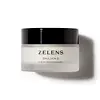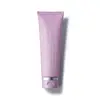What's inside
What's inside
 Key Ingredients
Key Ingredients

 Benefits
Benefits

 Concerns
Concerns

 Ingredients Side-by-side
Ingredients Side-by-side

Water
Skin ConditioningGlycerin
HumectantBehenyl Alcohol
EmollientCoco-Caprylate/Caprate
EmollientGlyceryl Stearate
EmollientDimethicone
EmollientPanthenyl Triacetate
Ethyl Linoleate
EmollientTrehalose
HumectantLinoleic Acid
CleansingLinolenic Acid
CleansingOleic Acid
EmollientCeramide Ns
Skin ConditioningPhospholipids
Skin ConditioningMethyl Cyclodextrin
7-Dehydrocholesterol
Emulsion StabilisingGlycolipids
Skin ConditioningGlycine Soja Sterols
EmollientPerilla Frutescens Leaf Extract
MaskingAlpha-Glucan Oligosaccharide
CleansingPolymnia Sonchifolia Root Juice
Skin ConditioningTocopherol
AntioxidantPropanediol
SolventOrnithine
Skin ConditioningSaccharomyces Ferment Lysate Filtrate
Skin ConditioningCholesterol
EmollientLactobacillus
Skin ConditioningPalmitic Acid
EmollientStearic Acid
CleansingLecithin
EmollientInulin Lauryl Carbamate
Emulsion StabilisingHydrogenated Lecithin
EmulsifyingBenzyl Alcohol
PerfumingCarbomer
Emulsion StabilisingSodium Dehydroacetate
PreservativeLauryl Alcohol
EmollientLevulinic Acid
PerfumingP-Anisic Acid
MaskingSodium Hydroxide
BufferingMyristyl Alcohol
EmollientCetyl Alcohol
EmollientOleyl Alcohol
EmollientDehydroacetic Acid
PreservativeOctyldodecanol
EmollientMaltodextrin
AbsorbentCitric Acid
BufferingSodium Benzoate
MaskingPotassium Sorbate
PreservativeWater, Glycerin, Behenyl Alcohol, Coco-Caprylate/Caprate, Glyceryl Stearate, Dimethicone, Panthenyl Triacetate, Ethyl Linoleate, Trehalose, Linoleic Acid, Linolenic Acid, Oleic Acid, Ceramide Ns, Phospholipids, Methyl Cyclodextrin, 7-Dehydrocholesterol, Glycolipids, Glycine Soja Sterols, Perilla Frutescens Leaf Extract, Alpha-Glucan Oligosaccharide, Polymnia Sonchifolia Root Juice, Tocopherol, Propanediol, Ornithine, Saccharomyces Ferment Lysate Filtrate, Cholesterol, Lactobacillus, Palmitic Acid, Stearic Acid, Lecithin, Inulin Lauryl Carbamate, Hydrogenated Lecithin, Benzyl Alcohol, Carbomer, Sodium Dehydroacetate, Lauryl Alcohol, Levulinic Acid, P-Anisic Acid, Sodium Hydroxide, Myristyl Alcohol, Cetyl Alcohol, Oleyl Alcohol, Dehydroacetic Acid, Octyldodecanol, Maltodextrin, Citric Acid, Sodium Benzoate, Potassium Sorbate
Water
Skin ConditioningCaprylic/Capric Triglyceride
MaskingGlycerin
HumectantPolyglyceryl-3 Methylglucose Distearate
EmulsifyingPropanediol
SolventGlyceryl Stearate
EmollientCetearyl Alcohol
EmollientXylitylglucoside
HumectantBetaine
HumectantPhospholipids
Skin ConditioningLinoleic Acid
CleansingGlycine Soja Sterols
EmollientCeramide NP
Skin ConditioningCeramide AP
Skin ConditioningCeramide EOP
Skin ConditioningPhytosphingosine
Skin ConditioningCholesterol
EmollientAloe Barbadensis Leaf Juice
Skin ConditioningTasmannia Lanceolata Fruit/Leaf Extract
AntioxidantCucumis Sativus Seed Oil
EmollientEctoin
Skin ConditioningHydroxyectoin
BufferingSodium Lauroyl Lactylate
EmulsifyingZingiber Officinale Root Extract
MaskingBisabolol
MaskingTocopherol
AntioxidantRosmarinus Officinalis Leaf Extract
AntimicrobialCarbomer
Emulsion StabilisingAnhydroxylitol
HumectantOryza Sativa Bran Extract
Skin Conditioning1,2-Hexanediol
Skin ConditioningStearic Acid
CleansingSodium Lauroyl Glutamate
Saccharide Isomerate
HumectantXylitol
HumectantTrisodium Ethylenediamine Disuccinate
Caprylhydroxamic Acid
Helianthus Annuus Seed Oil
EmollientXanthan Gum
EmulsifyingCitric Acid
BufferingSodium Citrate
BufferingWater, Caprylic/Capric Triglyceride, Glycerin, Polyglyceryl-3 Methylglucose Distearate, Propanediol, Glyceryl Stearate, Cetearyl Alcohol, Xylitylglucoside, Betaine, Phospholipids, Linoleic Acid, Glycine Soja Sterols, Ceramide NP, Ceramide AP, Ceramide EOP, Phytosphingosine, Cholesterol, Aloe Barbadensis Leaf Juice, Tasmannia Lanceolata Fruit/Leaf Extract, Cucumis Sativus Seed Oil, Ectoin, Hydroxyectoin, Sodium Lauroyl Lactylate, Zingiber Officinale Root Extract, Bisabolol, Tocopherol, Rosmarinus Officinalis Leaf Extract, Carbomer, Anhydroxylitol, Oryza Sativa Bran Extract, 1,2-Hexanediol, Stearic Acid, Sodium Lauroyl Glutamate, Saccharide Isomerate, Xylitol, Trisodium Ethylenediamine Disuccinate, Caprylhydroxamic Acid, Helianthus Annuus Seed Oil, Xanthan Gum, Citric Acid, Sodium Citrate
 Reviews
Reviews

Ingredients Explained
These ingredients are found in both products.
Ingredients higher up in an ingredient list are typically present in a larger amount.
Carbomer is a polymer of acrylic acid. Its main role is to create a gel consistency.
A high amount of carbomer can cause pilling or balling up of products. Don't worry, most products contain 1% or less of carbomer.
Cholesterol is a class of organic molecules called lipids. It helps hydrate your skin and is essential to having a healthy skin barrier.
Our skin naturally contains cholesterol in the outermost layer. Besides cholesterol, it also contains ceramides and fatty acids. Cholesterol makes up about 1/4 of your skin's outer layer and barrier. Your skin barrier is responsible for keeping allergens and microbes out. Having a healthy skin barrier is also responsible for keeping your skin firm and plump.
Our bodies use cholestrol to create vitamin D, steroid hormones, and more.
Learn more about CholesterolCitric Acid is an alpha hydroxy acid (AHA) naturally found in citrus fruits like oranges, lemons, and limes.
Like other AHAs, citric acid can exfoliate skin by breaking down the bonds that hold dead skin cells together. This helps reveal smoother and brighter skin underneath.
However, this exfoliating effect only happens at high concentrations (20%) which can be hard to find in cosmetic products.
Due to this, citric acid is usually included in small amounts as a pH adjuster. This helps keep products slightly more acidic and compatible with skin's natural pH.
In skincare formulas, citric acid can:
While it can provide some skin benefits, research shows lactic acid and glycolic acid are generally more effective and less irritating exfoliants.
Most citric acid used in skincare today is made by fermenting sugars (usually from molasses). This synthetic version is identical to the natural citrus form but easier to stabilize and use in formulations.
Read more about some other popular AHA's here:
Learn more about Citric AcidGlycerin is already naturally found in your skin. It helps moisturize and protect your skin.
A study from 2016 found glycerin to be more effective as a humectant than AHAs and hyaluronic acid.
As a humectant, it helps the skin stay hydrated by pulling moisture to your skin. The low molecular weight of glycerin allows it to pull moisture into the deeper layers of your skin.
Hydrated skin improves your skin barrier; Your skin barrier helps protect against irritants and bacteria.
Glycerin has also been found to have antimicrobial and antiviral properties. Due to these properties, glycerin is often used in wound and burn treatments.
In cosmetics, glycerin is usually derived from plants such as soybean or palm. However, it can also be sourced from animals, such as tallow or animal fat.
This ingredient is organic, colorless, odorless, and non-toxic.
Glycerin is the name for this ingredient in American English. British English uses Glycerol/Glycerine.
Learn more about GlycerinGlyceryl Stearate is a mix of glycerin and stearic acid.
It is used to stabilize the mixing of water and oil ingredients. By preventing these ingredients from separating, it can help elongate shelf life. It can also help thicken the product's texture.
As an emollient, it helps soften skin and supports barrier-replenishing ingredients.
In cosmetics, Glyceryl Stearate is often made from vegetable oils or synthetically produced.
This ingredient may not be fungal-acne safe
Fun fact: The human body also creates Glyceryl Stearate naturally.
Learn more about Glyceryl StearateGlycine Soja Sterols is derived from the soybean plant. Sterols are an organic compound and technically an alcohol.
Unlike solvent alcohols, glycine soja sterols have emollient properties and help hydrate the skin.
This ingredient may not be Malassezia folliculitis, or fungal-acne safe.
Sterols can be found in plants, animals, and fungi.
Learn more about Glycine Soja SterolsLinoleic Acid is also known as Vitamin F. It is a fatty acid with emollient and skin conditioning properties. Our top layer of skin, or epidermis, contains high amounts of linoleic acid naturally.
Your body uses linoleic acid to build ceramides and prostaglandins. Ceramides keep your skin's barrier hydrated and strong while prosaglandins help control inflammation and healing. Needless to say, linoleic acid is crucial for having a strong skin barrier.
One study found applying linoleic acid rich sunflower oil to be more effective at repairing the skin barrier than oleic rich olive oil.
Linoleic acid is an essential fatty acid, meaning our bodies cannot create it on its own. We need to get linoleic acid through foods such as nuts and vegetable oils.
Acne-prone skin tends to have linoleic acid and high levels of oleic acid.
Linoleic acid can also help treat acne by softening sebum to prevent clogged pores. Another study found using 2.5% linoleic acid gel for 4 weeks showed a 25% reduction in small comedones.
This ingredient can also help lighten hyperpigmentation or sun spots by disrupting the melanin production process. It also helps your skin shed melanin pigment from your skin caused by UV exposure.
Due to its role in the production of the fatty acid prostaglandin, linoleic acid can also help reduce inflammation and support wound healing.
Linoleic acid is not always fungal-acne safe; it may trigger flare-ups in sensitive individuals.
Learn more about Linoleic AcidPhospholipids are naturally found in our skin as they are the main component of cell membranes. Phospholipids have humectant, emollient, antioxidant properties.
Phospholipids are complex lipids that contain glycerin, two fatty acids, and a phosphate group. Some foods that contain phospholipids include soybeans and milk. The phospholipids found in soy come from Lecithin. This ingredient can also be synthetically created.
Due to their hygroscopic nature, they act as both humectants and emollients. Humectants draw moisture from the air to your skin, while emollients help trap moisture in.
The phospholipids in our skin can be naturally depleted. Replenishing the phospholipids in our skin can help hydrate your skin.
Studies show phospholipids display antioxidant activity and may help with reducing the signs of aging.
This ingredient is non-occlusive.
Some types of phospholipids:
Learn more about PhospholipidsPropanediol is an all-star ingredient. It softens, hydrates, and smooths the skin.
It’s often used to:
Propanediol is not likely to cause sensitivity and considered safe to use. It is derived from corn or petroleum with a clear color and no scent.
Learn more about PropanediolStearic Acid is a fatty acid. It is an emollient, emulsifier, and texture enhancer.
As an emollient, stearic acid helps soften skin. It aids the skin's protective barrier by preventing water loss. It also provides a gentle cleansing effect without stripping away natural oils.
Stearic acid may also be used to enhance the texture of products. It can add volume and stabilize ingredients such as water and oil. This can help water and oil ingredients from separating.
Sources of stearic acid include animal or vegetable fats/oils such as coconut or shea. It can be naturally found in butter, cocoa butter, shea butter, vegetable fats, and animal tallow.
This ingredient may not be Malassezia folliculitis, or fungal-acne safe.
Learn more about Stearic AcidTocopherol (also known as Vitamin E) is a common antioxidant used to help protect the skin from free-radicals and strengthen the skin barrier. It's also fat soluble - this means our skin is great at absorbing it.
Vitamin E also helps keep your natural skin lipids healthy. Your lipid skin barrier naturally consists of lipids, ceramides, and fatty acids. Vitamin E offers extra protection for your skin’s lipid barrier, keeping your skin healthy and nourished.
Another benefit is a bit of UV protection. Vitamin E helps reduce the damage caused by UVB rays. (It should not replace your sunscreen). Combining it with Vitamin C can decrease sunburned cells and hyperpigmentation after UV exposure.
You might have noticed Vitamin E + C often paired together. This is because it is great at stabilizing Vitamin C. Using the two together helps increase the effectiveness of both ingredients.
There are often claims that Vitamin E can reduce/prevent scarring, but these claims haven't been confirmed by scientific research.
Learn more about TocopherolWater. It's the most common cosmetic ingredient of all. You'll usually see it at the top of ingredient lists, meaning that it makes up the largest part of the product.
So why is it so popular? Water most often acts as a solvent - this means that it helps dissolve other ingredients into the formulation.
You'll also recognize water as that liquid we all need to stay alive. If you see this, drink a glass of water. Stay hydrated!
Learn more about Water